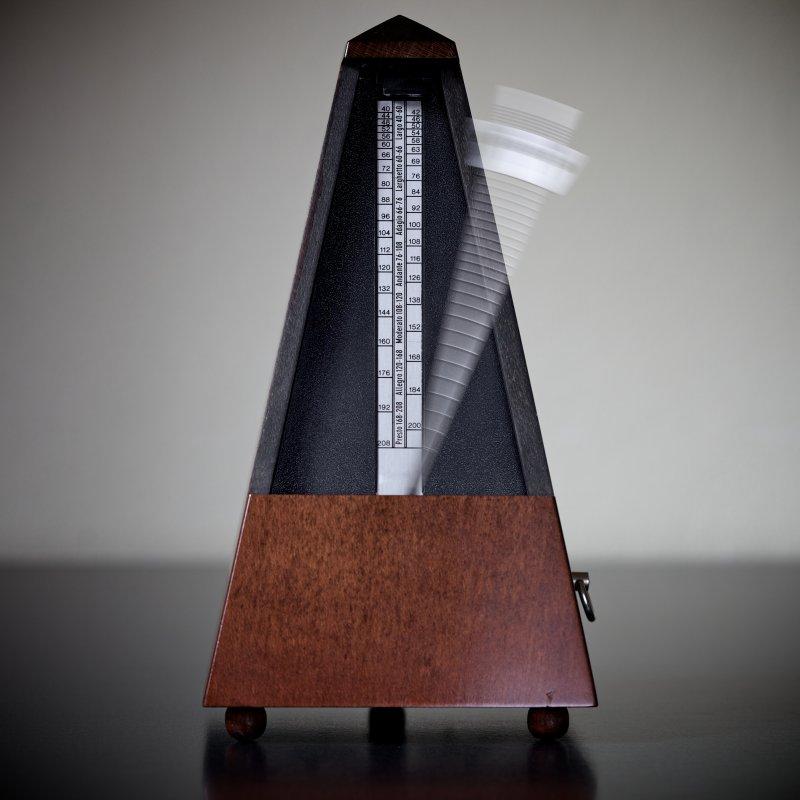As a vocalist, should you practice singing with a metronome at your side? Read on for St. Augustine, FL teacher Heather L.‘s advice…
Are you a singer who is looking to improve your timing and accuracy when you sing? If so, then you may have considered using a metronome.
Metronomes are tools that can be used to help singers keep time when they sing. In this blog post, we will discuss the pros and cons of singing with a metronome.
We will also provide some tips on how to use a metronome effectively when singing. Stay tuned!
How Do You Sing With Tempo?
When you are singing with tempo, it is important to keep a steady beat. You can do this by:
- Keeping time with your feet
- Clapping your hands
- Tapping your fingers
- Using a metronome
It is also important to breathe evenly and not hold your breath while you are singing. If you need to take a breath, make sure to do so between phrases and not in the middle of a phrase.
You should also try to match the tempo of the music you are singing with the tempo of your breathing. In other words, if the music is fast, your breathing should be fast. If the music is slow, your breathing should be slow.
By following these tips, you will be able to sing with tempo and stay on pitch at the same time.
Need help singing with tempo – and singing with a metronome? Signing up for singing lessons is a smart choice. You can learn everything you need to know about singing with a metronome, along with helpful tips like the ones you see in the video below:
https://www.youtube.com/watch?v=UDbAiaLR5Mw
What is Vocal Rhythm in Singing?
A singer’s vocal rhythm is the manner in which they sing the melody of a song. It can be fast or slow, even or choppy, and is an important element of a singer’s overall style.
Vocal rhythm is often determined by the genre of music a singer is performing, as well as the tempo of the song.
For instance, a blues singer might use a slow, soulful vocal rhythm, while a pop singer might sing with a quicker, more staccato rhythm. No matter what style of singing you prefer, developing a strong sense of vocal rhythm is essential for sounding your best.
What is a Metronome?
Metronomes are devices that produce sounds in regular, pre-chosen rhythms. Many years ago, the only metronomes were simple gadgets. Though the first one that’s even similar to what we now think of as a “modern” metronome was invented in the 19th century, the kind that most adults are familiar with is a mechanical, wind-up metronome.
It makes a sound like someone knocking on a small door. Nowadays, nifty electronic metronomes are manufactured on their own, or in a small device combined with a tuner, and they can now even be found online and on your smartphone as an app. They are utterly customizable, and I’m not talking just about the time signature, but even the sound itself.
Pros and Cons of Using a Metronome
So many musicians use a metronome all the time, but there’s always been a lot of debate on whether or not they’re even effective.
Metronomes are one of the most controversial tools in the music world. Some musicians swear by them, while others argue that they only serve to stifle creativity.
Overall, there are both pros and cons to using a metronome. It ultimately comes down to personal preference and what works best for you as a musician.
On the plus side, metronomes can be extremely helpful for developing a sense of timing and rhythm. They can also be used to help learn complex pieces of music by breaking them down into smaller, more manageable sections. In addition, metronome singing can help to prevent mistakes by keeping you on track and ensuring that you stay in time.
On the downside, some musicians find that metronomes can be restrictive and difficult to use. They can also make it difficult to feel the natural flow and groove of a piece of music. In addition, if not used correctly, metronomes can actually make it harder to keep time.
Supporters of its use say that it helps to encourage an internal sense of rhythm, it helps to keep musicians playing at a constant speed (if they tend to have a tendency to speed up or slow down), and because you can set it to a composer’s indicated tempo marking, you can get a true idea of the speed he or she wanted the piece to be played.
Opponents of the metronome claim that it simply creates mindlessly mechanical musicians, devoid of music expressiveness.
Over the last decade of teaching piano, I’ve used a metronome sparingly, fearing that students would go insane if I played it incessantly. But recently, I’ve found it more and more useful. Overall, I’ve come to believe that pianists, especially those in the beginner and intermediate stages, need a metronome. But do singers need a metronome?
Using a Metronome for Singing Practice
I taught a voice lesson this morning to a 65-year-old female student. She is a complete beginner who has a lot of promise. Because it’s so important that all of my students learn to sight read, I made sure that I got an intensive session in for her today. In the middle of sight reading melodies, she suddenly asked, “Why is that dot round and without a stem?”
She was asking what a whole note is. As I explained note rhythms, and specifically that a whole note is one that’s sung or played for four beats, I realized how much I needed a metronome in that moment. I would’ve played my guitar, the metronome would’ve sounded its steady beat, and my student would’ve heard that steady beat in the background as she sang. As she sang that whole note, she could’ve heard four beats go by. That would’ve reinforced her learning aurally.
Sure, I was able to strum and tap my guitar side to get a similar effect, but what happens to my student tomorrow when she goes to practice singing on her own? She doesn’t play an instrument. And even if she did that doesn’t mean at her beginning stage that she’d be sure to stay consistent in her rhythms.
Yes, music is a living thing, and living things naturally slow down and speed up. Music is a living thing that lives inside us, not on a written page. That page is a guide, a map that shows us the way. But it’s not the way. Rubato, for instance, is an Italian term that means literally “to rob,” and musically, it means to slow down and take time away, so to speak, only to “give it back” and speed up later on. It’s a beautiful thing. But metronomes don’t know rubato. They are faithful, true, and dependable, which is exactly why they’re so important for your musical studies.
Other Ways a Metronome Can Help
Singers need metronomes. A lot of composers and even songwriters include very particular, and even not so particular, tempo markings in their works. These markings go from vague, like “with movement,” to an exact number of beats per minute, like 132. Unless you know just what 132 beats per minute sounds like, when you see that 132 on your page of music, you’ll just be guessing. And have you ever slowed down or sped up in song, without even knowing it? Me, too. Metronomes help.
Think of the last time that you sang with another musician. Did you find yourselves having to take a few minutes to talk about exactly what tempo you’d play? Did you get a little frustrated when someone sped up on his own? A metronome would’ve helped.
How Do You Practice a Song With a Metronome?
Before you can perform a song with a metronome, there are a few things you need to do to prepare.
First, you need to determine the tempo of the song. You can do this by using a metronome, or by counting the number of beats in a minute. Once you know the tempo, you can set the metronome to that speed.
Next, you need to choose which hand you will use to keep time with the metronome. If you are right-handed, it is generally best to use your left hand, and vice versa.
Finally, you need to determine which notes will fall on the downbeats and which will fall on the upbeats.
Once you have all of this information, you are ready to begin practicing with the metronome. Start by playing a single note on the downbeat, and then add more notes on subsequent beats.
As you get comfortable with the timing, you can start to experiment with different rhythms and patterns.
With practice, you will be able to play any song with a metronome without missing a beat.
How to Keep Rhythm While Singing: Other Tips
Besides practicing with a metronome, there are other ways you can keep rhythm while singing.
One way is to clap along with the music as you sing. This will help you keep time with the beat and stay on track. You can also practice tapping your foot to the beat of the music. This will help you feel the pulse of the song and keep you from rushing or slowing down.
Another helpful tip is to count out loud as you sing. This will ensure that you are staying on beat and not rushing through the lyrics.
Finally, try to find a song that has a similar tempo to the one you are singing. This will help you stay in time with the music and avoid rushing or slowing down. By following these tips, you will be well on your way to keeping rhythm while singing.
How to Sing on Beat: A Metronome Can Help!
Many people think that they can’t sing on beat because they don’t have a “natural sense of rhythm.” However, the ability to sing on beat is mostly a matter of practice.
And one of the best tools for practicing is singing with a metronome. A metronome is a device that keeps a steady beat, which can be adjusted to any tempo. By setting the metronome to a slow tempo and singing along, you can gradually train your ear to hear the beat and match your voice to it. You can also use the metronome to practice speeding up or slowing down your singing to match the changes in tempo of a song. With enough practice (and perhaps by taking singing lessons!), you’ll be able to keep perfect time without even thinking about it! So don’t be discouraged if you can’t sing on beat at first – with a little help from a metronone, you’ll be hitting all the right notes in no time.
In the end, the metronome becomes a trusty friend, there whenever you need it. But someone doesn’t have to be your roommate to be a trusty friend. And your metronome doesn’t have to be a nagging, annoying, or constant companion. You can be simply friends, and what a great friend it is to have.
 Heather L. teaches singing, piano, acting, and more in St. Augustine, FL, as well as through online lessons. She is a graduate of the prestigious Westminster Choir College in Princeton, New Jersey, and has performed with the New York and Royal Philharmonics, the New Jersey and Virginia Symphonies, the American Boy Choir, and the internationally renowned opera star Andrea Bocelli. Learn more about Heather here!
Heather L. teaches singing, piano, acting, and more in St. Augustine, FL, as well as through online lessons. She is a graduate of the prestigious Westminster Choir College in Princeton, New Jersey, and has performed with the New York and Royal Philharmonics, the New Jersey and Virginia Symphonies, the American Boy Choir, and the internationally renowned opera star Andrea Bocelli. Learn more about Heather here!
Photo by Niki Odolphie
Suzy S.

